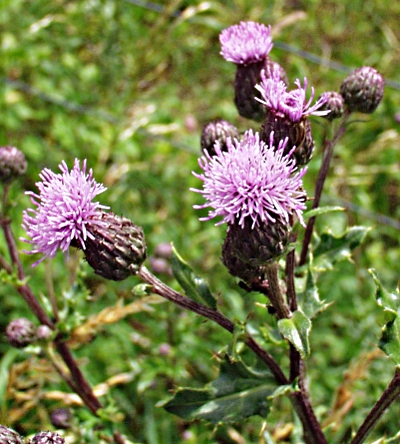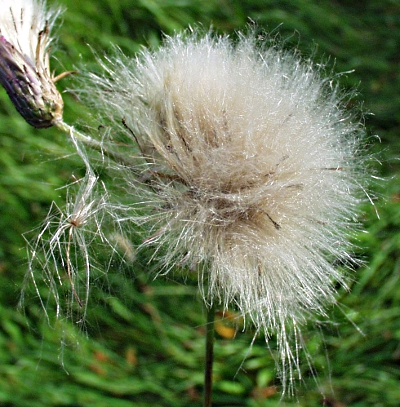Creeping thistle |



Inflorescence, infructescence and leaf from Cirsium arvense
| Cirsium arvense (L.) Scop.: | |
| Blooming period: | July–September |
| Height: | 30–160 cm |
| Flowers: | in heads, Ø of the ♂ heads approx. 30 mm, Ø of the ♀ heads approx. 17 mm, stamens: 5, styles: 1 |
| Ray florets: | missing |
| Disc florets: | purple |
| Calyx: | transformed into a pappus |
| Stem leaves | alternate, oblong-elliptic, mucronate |
| Basal leaves: | missing at the flowering season |
Plant
perennial, herbaceous, with a deep taproot
and with long subterranean
stolons.
Stem
erect, branched in the upper part,
glabrous to grey tomentose, not spiny winged.
Stem leaves alternate, shortly decurrent, simple to lobed, slightly amplexicaul, underneath glabrous to grey tomentose, above without spines or bristles, leaf margins usually curly, often sinuate-dentate and spiny toothed. Leaves decrease upwards in size, mostly sessile.
Flower heads rarely solitary, usually clustered in racemose to corymbose inflorescences. They appear on very short stalks which are about 7 cm long, leafless and sometimes tomentose. Receptacle flat and bristly.
The phyllaries are arranged imbricated in 5–8 rows. Outer ones ovate-triangular, inner ones linear, often tinged violet. Involucre elliptical.
The flower head consists exclusively of purple or rarely white tubular flowers which are filiform, 12–20 mm long, unisexual and 5-lobed. Female ones generally longer than male ones. Florets at the base without chaffy leaves.
Plants dioecious to gynodioecious (male and female flower heads on different plants or hermaphrodite and female flower heads on different plants).
After pollination by bees, bumblebees, wasps or butterflies, occasionally even after self-pollination, the inferior ovary forms a 2–4 mm long nut fruit (achene) which is brown or yellowish, oblong-round to slightly 4-edged. At the apex with about 30 mm long, feathery, off-white sailing hairs. Plants diversiform!
Cirsium arvense may form bastards with C. oleraceum, C. palustre and C. vulgare.
| Floral formula: |
| * K=pappus [C(5) A0]
G(2) inferior or * K=pappus [C(5) A5(connate)] G0 |
Occurrence:
Waysides
and roadsides, fields, fallow land, ruderal areas. Prefers slightly
warm and nitrogen-rich locations. Plant halotolerant.
Distribution:
Originally Eurasia,
introduced with seed, in America, Australia and Africa.